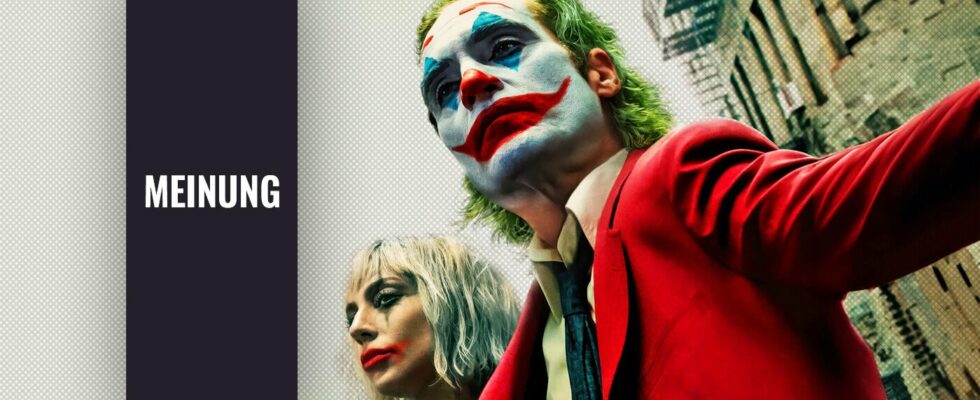A week after the theatrical release of Joker: Folie à Deux, discussions about the DC sequel have by no means subsided. The longer the film runs, the more perspectives are revealed controversial and idiosyncratic comic blockbusterwho is primarily interested in one thing: subverting expectations.
Folie à Deux is not the ultimate Joker mayhem film that many fans expected. Instead, he negotiates the finale of the original with the bitter lack of compromise of a prison and court film, while musical elements are sprinkled in between. Far too little is said about a striking scene.
Be careful, follow it spoiler to the film!
Self-critical DC blockbuster: Joker 2 literally goes to court with the end of the first part
The second Joker film deals in depth with the consequences of the first part. We remember: Arthur Fleck (Joaquin Phoenix) shoots talk show host Franklin Murray (Robert De Niro) in front of the camera. Four or five more murders are on his account. That’s why he’s now in Arkham Asylum, which in Folie à Deux is more of a prison than a psychiatric institution. An unfriendly place, either way.
It will later be decided in court whether Arthur Fleck and Joker are two different personalities. Really became Joker born from painwhich Arthur had to experience in various ways throughout his life? Or does the villain have nothing to do with the humiliations of the past? Here we come to the critical scene that, strictly speaking, doesn’t appear in the film at all.
After Gary Puddles’ (Leigh Gill) testimony in court, Arthur is taken to the washroom in prison, has to undress and is raped by the guards around Jackie Sullivan (Brendan Gleeson). However, the film does not show the rape directly, but rather fades out shortly before. The next thing we see is the frail Arthur, visibly scarred by the violence he has just experienced.
The implied rape is intended to make Arthur Fleck’s development understandable
Director Todd Phillips, who also co-wrote the screenplay with Scott Silver, uses this moment to separate Arthur from the Joker identity. Although the followers around Harleen “Lee” Quinzel (Lady Gaga) would prefer to see the troublemaker with clown make-up in the courtroom, at this moment there is a break in which the Joker fantasy collapses completely for Arthur.
Arthur finds himself back in the powerless position from which he tried to escape using the Joker identity. He is caught in a vicious circle and realizes that the only thing the Joker is fueling just more suffering and violence is – for yourself and for others. First the heartbreaking encounter with Puddles, then the rape. Maybe Arthur Fleck is the real victim after all?
Speaking to Entertainment Weekly, Phillips makes it pretty clear:
He has accepted the fact that he has always been Arthur Fleck; he was never this thing that was pushed on him, this idea that the people of Gotham pushed on him that he represents. He is an unwilling icon. This thing has been imposed on him, and he doesn’t want to live as a fake anymore – he wants to be who he is.
Rarely has a character based on a superhero comic been portrayed as sadly as Arthur Fleck. Everything powerful about the Joker is gone. We follow one humiliation after another. The rape marks Arthur’s lowest point in the film. The fact that a $200 million blockbuster dares to venture into this abyss is not a given and illustrates the ambition of Folie à Duex.
Shock scene in DC blockbuster: Arthur Fleck’s rape in Joker 2 is just a means to an end
At the same time the scene stands still representative of the greatest weakness of the film: Phillips and Silver have a lot of ideas, but don’t know how to implement them. It starts harmlessly with clumsy musical sequences and, in the worst case scenario, escalates into rape (not shown). In the end, this only expands the film as a cliché and plot component without being examined for its meaning.
Can Arthur Fleck ever be forgiven? Joker: Folie à Deux doesn’t look for the next monster in the murderer, but rather a broken person and uses it in a very subtle way usual stations of the prison film back. Cold light, uncomfortable cells. And of course, abuse of power on the part of the guards, who initially act as bullies before becoming criminals themselves – all a means to an end.
For a film that so strenuously denies its origins as a comic book adaptation, it’s astonishing that Folie à Deux runs with more open arms into the entrenched routines of another genre and refuses to question them or follow them your own spin to lend. The story does not return to the rape. It only serves as a shock effect to accelerate character development.
The one time when Folie à Deux ventures into abysmal, uncomfortable territory and suggests a scene like her never appears in blockbuster cinemathe film lacks narrative vision. There is no discussion of what this moment means for Arthur and the world in which he shatters. It’s just another station that is dutifully completed so that the Joker becomes human again.
But what is a person in a film who traps his characters in rote discourse? That Arthur Fleck at the end disappears from the worldas if it had never existed, offers itself as a bitter answer. The final humiliation, so to speak. However, as with almost all stirring ideas, there is no convincing execution here. Folie à Deux only wants big gestures, the final bang.
Joker: Folie à Deux has been running since then October 3, 2024 in German cinemas.
